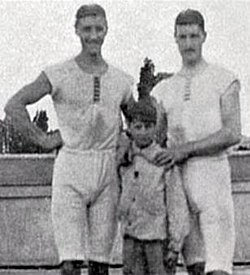1900 Summer Olympics
The Dutch coxed pair rowing team initially participated with an adult coxswain named Hermanus Brockmann, but realised that having three adults in the boat made it too heavy. Before the final, the rowers François Brandt and Roelof Klein randomly chose a child from the Parisian crowd to be their new coxswain. The boy was so light that they had to add a weight to the boat for it to maintain balance. [3] The lighter weight of the boy contributed to the team winning the race, beating the French boat by two-tenths of a second. [4] After winning, the three posed for a photograph before the boy disappeared back into the crowd. [3] [4]
Some historians believe the boy was around eight years old when he participated in the Olympics, which would make him the youngest Olympic champion in history. However, some researchers such as Tony Bijkerk believe that he was twelve or thirteen years old at the time, which would make him older than Dimitrios Loundras, a Greek gymnast who won bronze at ten years old. [5]
Identity
Historian Hilary Evans described the identity of the boy as "the biggest Olympics mystery of all", [5] while David Wallechinsky called it "the great mystery of Olympic history". [3] In the Olympic archives of Lausanne, he is never mentioned by name, instead being consistently listed as the "unknown French boy". The only known photograph of the boy was discovered by Tony Bijkerk, who spent nearly fifty years trying to uncover his identity. [5]
Bill Mallon, the official historian of the United States Olympic & Paralympic Committee, studied various French and German rowing magazines from the 1900s; none of these sources mention the coxswain. He interviewed one of the rowers' daughters in the 1980s, but she said that her father never spoke of the boy. [3]
In 2016, Georgian historian Paata Natsvlishvili hypothesized that the coxswain was not French at all, but actually a Georgian boy named Giorgi Nikoladze who had been touring Europe with his family at the time of the 1900 Summer Olympics. According to Natsvlishvili, Nikoladze's sister had told him in an interview in the 1980s that her brother had won a boat race in France during that period. As an adult, Giorgi Nikoladze became a mathematician, a metallurgist, and a professor at Tbilisi State University. [6] [7] However, some historians from the International Society of Olympic Historians remained unconvinced that Nikoladze was really the unknown coxswain owing to the circumstantial evidence. Bill Mallon said that the unknown boy only looked "a little" like Nikoladze. [3]
This page is based on this
Wikipedia article Text is available under the
CC BY-SA 4.0 license; additional terms may apply.
Images, videos and audio are available under their respective licenses.
